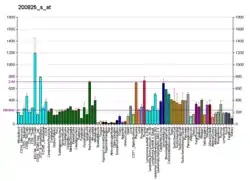HYOU1
Hypoxia up-regulated protein 1 is a protein that in humans is encoded by the HYOU1 gene.[5][6][7]
The protein encoded by this gene belongs to the heat shock protein 70 family. This gene has three mRNAs from the use of alternative transcription sites. A cis-acting segment is found at the 5' end of exon 1A which is involved in the stress-dependent induction. The transcript that begins with exon 1B is preferentially induced by hypoxia, resulting in the accumulation of this protein in the endoplasmic reticulum (ER).
The protein encoded by this gene is thought to play an important role in protein folding and secretion in the ER. Since suppression of the protein is associated with accelerated apoptosis, it is also suggested to have an important cytoprotective role in hypoxia-induced cellular perturbation. This protein has been shown to be up-regulated in tumors, especially in breast tumors, and thus it is associated with tumor invasiveness.
There is also an alternative translation site of this gene which lacks the signal peptide. This signal peptide-lacking protein, is only 3 amino acids shorter than the mature protein in the ER, and it is thought to have a housekeeping function in the cytosol.[7]
References
- ENSG00000149428 GRCh38: Ensembl release 89: ENSG00000280682, ENSG00000149428 - Ensembl, May 2017
- GRCm38: Ensembl release 89: ENSMUSG00000032115 - Ensembl, May 2017
- "Human PubMed Reference:". National Center for Biotechnology Information, U.S. National Library of Medicine.
- "Mouse PubMed Reference:". National Center for Biotechnology Information, U.S. National Library of Medicine.
- Ikeda J, Kaneda S, Kuwabara K, Ogawa S, Kobayashi T, Matsumoto M, Yura T, Yanagi H (Feb 1997). "Cloning and expression of cDNA encoding the human 150 kDa oxygen-regulated protein, ORP150". Biochem Biophys Res Commun. 230 (1): 94–9. doi:10.1006/bbrc.1996.5890. PMID 9020069.
- Ozawa K, Kuwabara K, Tamatani M, Takatsuji K, Tsukamoto Y, Kaneda S, Yanagi H, Stern DM, Eguchi Y, Tsujimoto Y, Ogawa S, Tohyama M (Mar 1999). "150-kDa oxygen-regulated protein (ORP150) suppresses hypoxia-induced apoptotic cell death". J Biol Chem. 274 (10): 6397–404. doi:10.1074/jbc.274.10.6397. PMID 10037731.
- "Entrez Gene: HYOU1 hypoxia up-regulated 1".
Further reading
- Maruyama K, Sugano S (1994). "Oligo-capping: a simple method to replace the cap structure of eukaryotic mRNAs with oligoribonucleotides". Gene. 138 (1–2): 171–4. doi:10.1016/0378-1119(94)90802-8. PMID 8125298.
- Tsukamoto Y, Kuwabara K, Hirota S, et al. (1996). "150-kD oxygen-regulated protein is expressed in human atherosclerotic plaques and allows mononuclear phagocytes to withstand cellular stress on exposure to hypoxia and modified low density lipoprotein". J. Clin. Invest. 98 (8): 1930–41. doi:10.1172/JCI118994. PMC 507633. PMID 8878445.
- Kuznetsov G, Chen LB, Nigam SK (1997). "Multiple molecular chaperones complex with misfolded large oligomeric glycoproteins in the endoplasmic reticulum". J. Biol. Chem. 272 (5): 3057–63. doi:10.1074/jbc.272.5.3057. PMID 9006956.
- Suzuki Y, Yoshitomo-Nakagawa K, Maruyama K, et al. (1997). "Construction and characterization of a full length-enriched and a 5'-end-enriched cDNA library". Gene. 200 (1–2): 149–56. doi:10.1016/S0378-1119(97)00411-3. PMID 9373149.
- Tsukamoto Y, Kuwabara K, Hirota S, et al. (1998). "Expression of the 150-kd oxygen-regulated protein in human breast cancer". Lab. Invest. 78 (6): 699–706. PMID 9645760.
- Bando Y, Ogawa S, Yamauchi A, et al. (2000). "150-kDa oxygen-regulated protein (ORP150) functions as a novel molecular chaperone in MDCK cells". Am. J. Physiol., Cell Physiol. 278 (6): C1172–82. doi:10.1152/ajpcell.2000.278.6.C1172. PMID 10837345. S2CID 1841205.
- Kaneda S, Yura T, Yanagi H (2000). "Production of three distinct mRNAs of 150 kDa oxygen-regulated protein (ORP150) by alternative promoters: preferential induction of one species under stress conditions". J. Biochem. 128 (3): 529–38. doi:10.1093/oxfordjournals.jbchem.a022783. PMID 10965054.
- Tamatani M, Matsuyama T, Yamaguchi A, et al. (2001). "ORP150 protects against hypoxia/ischemia-induced neuronal death". Nat. Med. 7 (3): 317–23. doi:10.1038/85463. PMID 11231630. S2CID 10152200.
- Strausberg RL, Feingold EA, Grouse LH, et al. (2003). "Generation and initial analysis of more than 15,000 full-length human and mouse cDNA sequences". Proc. Natl. Acad. Sci. U.S.A. 99 (26): 16899–903. Bibcode:2002PNAS...9916899M. doi:10.1073/pnas.242603899. PMC 139241. PMID 12477932.
- Zhang H, Li XJ, Martin DB, Aebersold R (2003). "Identification and quantification of N-linked glycoproteins using hydrazide chemistry, stable isotope labeling and mass spectrometry". Nat. Biotechnol. 21 (6): 660–6. doi:10.1038/nbt827. PMID 12754519. S2CID 581283.
- Bando Y, Tsukamoto Y, Katayama T, et al. (2005). "ORP150/HSP12A protects renal tubular epithelium from ischemia-induced cell death". FASEB J. 18 (12): 1401–3. doi:10.1096/fj.03-1161fje. PMID 15240565. S2CID 30637967.
- Ahmed M, Forsberg J, Bergsten P (2005). "Protein profiling of human pancreatic islets by two-dimensional gel electrophoresis and mass spectrometry". J. Proteome Res. 4 (3): 931–40. doi:10.1021/pr050024a. PMID 15952740.
- Lewandrowski U, Moebius J, Walter U, Sickmann A (2006). "Elucidation of N-glycosylation sites on human platelet proteins: a glycoproteomic approach". Mol. Cell. Proteomics. 5 (2): 226–33. doi:10.1074/mcp.M500324-MCP200. PMID 16263699.
- Liu T, Qian WJ, Gritsenko MA, et al. (2006). "Human plasma N-glycoproteome analysis by immunoaffinity subtraction, hydrazide chemistry, and mass spectrometry". J. Proteome Res. 4 (6): 2070–80. doi:10.1021/pr0502065. PMC 1850943. PMID 16335952.
- Cechowska-Pasko M, Bankowski E, Chene P (2006). "The effect of hypoxia on the expression of 150 kDa oxygen-regulated protein (ORP 150) in HeLa cells". Cell. Physiol. Biochem. 17 (1–2): 89–96. doi:10.1159/000091467. PMID 16543725.
- Takeuchi S (2007). "Molecular cloning, sequence, function and structural basis of human heart 150 kDa oxygen-regulated protein, an ER chaperone". Protein J. 25 (7–8): 517–28. doi:10.1007/s10930-006-9038-z. PMID 17131193. S2CID 41452314.
- Kitao Y, Matsuyama T, Takano K, et al. (2007). "Does ORP150/HSP12A protect dopaminergic neurons against MPTP/MPP(+)-induced neurotoxicity?". Antioxid. Redox Signal. 9 (5): 589–95. doi:10.1089/ars.2006.1518. PMID 17330988.
- Ewing RM, Chu P, Elisma F, et al. (2007). "Large-scale mapping of human protein-protein interactions by mass spectrometry". Mol. Syst. Biol. 3 (1): 89. doi:10.1038/msb4100134. PMC 1847948. PMID 17353931.




